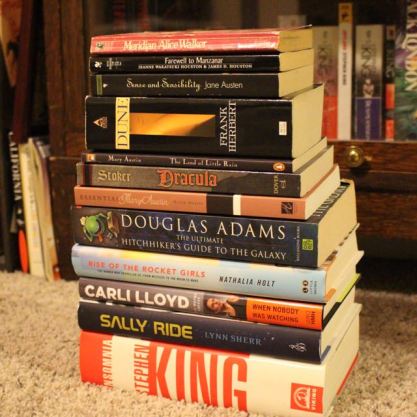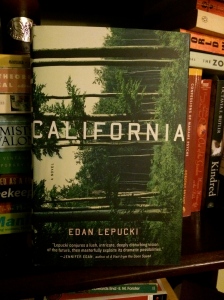At the end of the summer, my friend Jenni Buchanan does an excellent job compiling the syllabus for her book group, Rediscovering the Classics. One of my favorite meetings each year is the one where Jenni reveals the list for the year, which is based on a theme. This year’s theme is “Literary Life Lessons,” and it includes some interesting reads, activities and field trips paired with books. After the syllabus announcement meeting back in August, Jenni and I were going for a hike, and I was telling her how I envy the task of creating the reading list each year. I love lists, and I love books, so lists of books make me happy. Jenni’s response to me was, “Well, why don’t you make up some of your own reading lists?” So, that’s what I set out to do here.
These lists are made up of books that I have not read. Consider it a way for me to organize my to-be-read stack around themes. With only a few exceptions, most of these are in my personal library. I had quite a few books to choose from, given that my to-be-read stack is actually a three-shelf bookcase. Also, given that Dewey’s 24-Hour Readathon is only a few weeks away, I figured this is a good time to start building my reading pile in preparation for that event.
Women & Space
Before I was born, my mom worked as a computer programmer for the space program. She eventually ended up at the Jet Propulsion Laboratory (JPL), which is where she met my dad. Women in the space program have been getting a lot of attention recently, and there are some promising books out and an upcoming movie based on Hidden Figures. Here are my books on women and space:
- Sally Ride: America’s First Woman in Space by Lynn Sherr
I was fortunate to have the opportunity to meet Sally Ride in grad school when I was organizing an event where she was the main speaker. She was kind, intelligent and inspiring, so I am really looking forward to reading more about her amazing life. - Rise of the Rocket Girls: The Women Who Propelled Us, from Missiles to the Moon to Mars by Nathalia Holt
This book looks at the women known as “human computers” who used pencil and paper to do the complicated calculations necessary for space exploration. They were instrumental in building the U.S. space program and JPL. - Hidden Figures: The American Dream and the Untold Story of the Black Women Mathematicians Who Helped Win the Space Race by Margot Lee Shetterly
Shetterly introduces us to the women who were “human computers” in NASA’s early days, but Hidden Figures specifically looks at Black women who did the work of calculating things like flight paths by hand while also being segregated due to the Jim Crow laws of the time. Be sure to watch the trailer for the upcoming movie to get a glimpse of why it is so important that we recognize the outstanding achievements of this group of women.
Stephen King Books I Want to Read
Stephen King has written enough books to warrant his own list. I did not start reading King’s novels until about ten years ago when I picked up On Writing: A Memoir of the Craft. I had previously dismissed King as simply a horror writer, but as soon as I delved into his work, I realized I was wrong, and I had grossly underestimated his ability as a storyteller. Yes, there is horror, but more than that, he creates highly relatable characters and writes about childhood in a way that is nostalgic without being overly sentimental. King’s books are usually quick reads–even the ones that are well over 600 pages. They make for an excellent choice when you want a good book to get lost in. This list could be really long, but I will keep it short and limit it to unread King books in my personal library and a few others I hope to get my hands on soon:
- The Shining
- Insomnia
- Rose Madder
- The Dead Zone
- Different Seasons
- Misery
- Everything’s Eventual: 14 Dark Tales
Eastern California
Regular readers know that my favorite road buddy Tim Pershing and I love making adventures of our road trips. Tim’s family is in Reno, so we have made quite a few trips north and south on the 395 through Eastern California. On one trip we were stopped at a gas station in Independence, CA, and we saw a sign pointing toward Mary Austin‘s house. We both wondered who she was, so I got my phone out and started reading up on her. We learned she was a nature writer in the early 20th century and that she was involved in the famous California Water Wars that eventually resulted in water from the Owens Valley being drained to supply the growing city of Los Angeles. You can learn more about this and more history about the region at the Eastern California Museum in Independence. Eastern California is also home to Manzanar, one of the camps where Japanese Americans were incarcerated during World War II. If your travels take you through this part of California, be sure to stop at the Manzanar National Historical Site. Here are a few books I have picked up on my trips through Eastern California:
- The Land of Little Rain by Mary Austin
- Essential Mary Austin: A Selection of Mary Austin’s Best Writings
- Farewell to Manzanar by Jeanne Wakatsuki Houston and James D. Houston
- No Rooms of Their Own: Women Writers of Early California, 1849-1869 Edited by Ida Rae Egli
Soccer Stories
I have only been a fan of soccer in the last couple years, and I owe that to the U.S. women’s soccer team and their 2015 World Cup victory. After watching those games, I was hooked and began rooting for the Portland Thorns in the National Women’s Soccer League. We have been lucky this year to have two books hit the shelves by players from the 2015 World Cup team, and I have quickly added them both to my list. I recently attended a book signing for Carli Lloyd’s new book and was happy to see that the line stretched around the block. Anyone who doubts the popularity of women’s soccer should have seen the crowd gathered for her signing. So, here’s my short list of soccer stories to read:
- When Nobody Was Watching: My Hard-Fought Journey to the Top of the Soccer World by Carli Lloyd
- Forward: A Memoir by Abby Wambach
Alexander Hamilton
I am hooked on the soundtrack for Hamilton, and often when I am listening to it, I find myself googling details about the founding fathers and the early decades of our country’s existence. What I am really enjoying about Hamilton‘s popularity is that many others are finding a new interest in this part of our history. Lin-Manuel Miranda’s musical has brought history alive in a creative way and opens up new ways to see and connect with the founding of the U.S. With that, I would like to tackle these two books:
- Alexander Hamilton by Ron Chernow
This is the book that inspired Lin-Manuel Miranda to write Hamilton. I read the first page of the prologue and got chills. The writing is just that good. I get the feeling that this is not some dry, old history book. - Hamilton: The Revolution by Lin-Manuel Miranda and Jeremy McCarter
Hamilton fans lovingly refer to this as the Hamiltome because of its size and extensive content. There are pictures, lyrics, notes, commentary and just about anything fans of the show could want. It is a good way to keep yourself busy while you wait for Hamilton’s America to premiere on PBS.
Books I Should Have Already Read
Have you ever been talking to people about books, and they start bringing up certain classics or other well-known works, and you stand there quietly, afraid to admit that you have not read the book being discussed? I think we all have those books–they are the ones that our friends are surprised to hear we have not read. I have slowly been trying to collect some of these when I visit used bookstores, and here are some of the titles currently in my to-be-read stack:
- The Hitchhiker’s Guide to the Galaxy by Douglas Adams
- I Know Why the Caged Bird Sings by Maya Angelou
- Sense and Sensibility by Jane Austen
- A Walk in the Woods: Rediscovering America on the Appalachian Trail by Bill Bryson
- Like Water for Chocolate by Laura Esquivel
- Dune by Frank Herbert
- Love in the Time of Cholera by Gabriel García Márquez
- The Bluest Eye by Toni Morrison
- Dracula by Bram Stoker
- Meridian by Alice Walker

